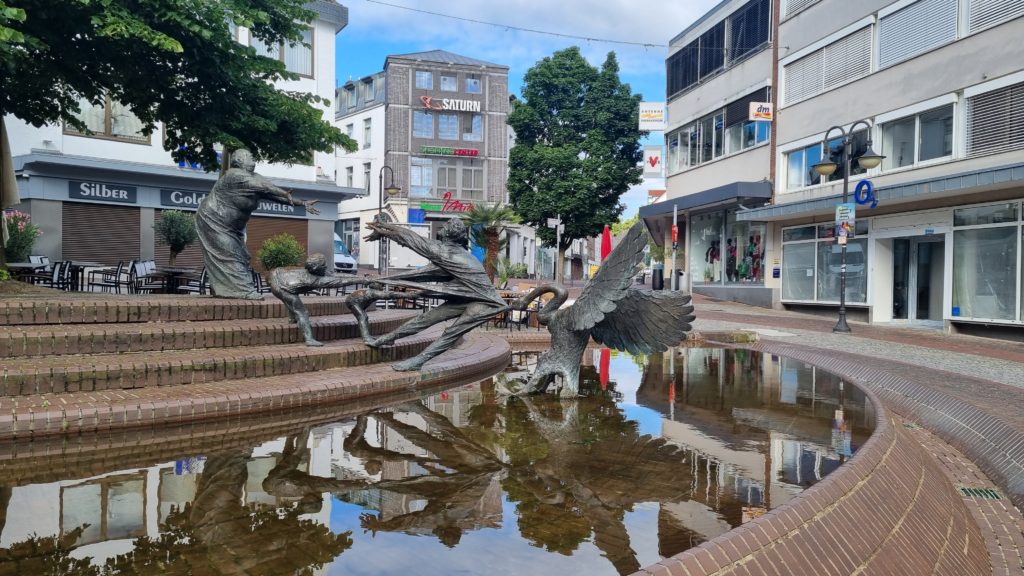A Playful Wagnerian Fountain in Kleve
In the lively town center of Kleve, the Lohengrinbrunnen, also known as the Elsabrunnen, stands as a captivating and humorous tribute to Richard Wagner’s opera Lohengrin. This unique fountain combines mythology, art, and a touch of modern humor, making it a fascinating stop for visitors. It brings the legendary figures of Lohengrin and Elsa to life in a way that invites both reflection and amusement.


A Humorous Twist on a Classic Legend
At the heart of this sculpture is the legendary Lohengrin, the knight who arrives by a mystical swan to rescue Elsa, as told in Wagner’s famed opera. However, the Lohengrinbrunnen offers a whimsical take on the tale: Lohengrin is sculpted with the likeness of Richard Wagner himself, while Elsa is portrayed as a larger-than-life opera singer, exuding the dramatic flair often associated with Wagner’s heroines.
The real twist comes with the addition of two playful children pulling on Lohengrin’s cloak, as if trying to stop him from leaving his family behind. Meanwhile, the determined swan tugs at him from the other side, symbolizing his duty to a higher calling. This humorous scene reflects the eternal struggle between personal commitments and destiny, a theme often explored in Wagner’s works.
The Artist and the Creation of the Lohengrinbrunnen
The Lohengrinbrunnen was created by the talented sculptor Karl-Henning Seemann in 1987. Seemann was known for his ability to blend traditional mythological subjects with a modern, often ironic perspective. His approach to this piece demonstrates his skill in using public art to engage viewers, encouraging them not only to appreciate the artistry but also to think about the deeper meanings behind the sculpture.
Seemann’s work often explored the tension between duty and personal desire, themes that are central to the Lohengrin legend. By giving Lohengrin the facial features of Wagner, Seemann adds another layer of meaning—perhaps suggesting the artist’s own struggle with the expectations placed upon him. The exaggerated portrayal of Elsa as an opera diva adds a light-hearted element to what could otherwise be a solemn story.
The Design and Symbolism of the Fountain
The Lohengrinbrunnen is not just about the figures it portrays; the fountain itself is a piece of architectural art. The stepped, circular brick design provides a platform for the action to unfold, with reflective water surrounding the sculptures. This reflective quality adds depth to the scene, inviting viewers to see the figures and their surroundings from different angles.
The swan in the sculpture plays a crucial role, symbolizing Lohengrin’s divine mission to protect and serve. Its graceful form contrasts with the struggle depicted by the children and Elsa. This tension creates a dynamic scene, as if Lohengrin is caught between two worlds: the earthly life represented by his family, and the divine, represented by the swan.
A Cultural Landmark in the Heart of Kleve
Today, the Lohengrinbrunnen is not just a piece of art; it is a beloved cultural landmark for the people of Kleve. Its central location makes it a popular meeting point and a place of reflection for locals and tourists alike. Cafés and shops line the square where the fountain stands, offering visitors the chance to relax and enjoy the atmosphere while contemplating the deeper meaning behind the artwork.
Why Visit the Lohengrinbrunnen?
Whether you’re a fan of Richard Wagner, interested in public art, or simply intrigued by the fusion of myth and humor, the Lohengrinbrunnen is a must-see during any visit to Kleve. The playful interaction between the characters, combined with the masterful sculpting of Karl-Henning Seemann, makes this fountain a unique and thought-provoking piece of public art.
Standing before the fountain, you’re invited to ponder the eternal struggle between personal duty and destiny, all while appreciating the clever and humorous way in which these themes are presented. The Lohengrinbrunnen truly captures the spirit of Kleve: a place where history, art, and culture come together to create a vibrant, welcoming community.